Chapter 16: The GUI and the personal computer
16.1 Xerox PARC
 In 1975 the researchers at Xerox PARC (Palo Alto Research Center) moved into their permanent headquarters at 3333 Coyote Hill Road near Stanford University in Palo Alto, California. Jacob Goldman had founded PARC just five years previous, and already at this early date the research team had developed many of the ideas that shaped the future of computing.[1]
In 1975 the researchers at Xerox PARC (Palo Alto Research Center) moved into their permanent headquarters at 3333 Coyote Hill Road near Stanford University in Palo Alto, California. Jacob Goldman had founded PARC just five years previous, and already at this early date the research team had developed many of the ideas that shaped the future of computing.[1]
The Palo Alto Research Center’s mission as directed by Xerox management was to create the office of the future. To that end they created many of the technologies we take for granted in the modern office, such as networked personal computers, with email, word processing, and laser printing, but the most significant innovation at PARC was the graphical user interface (GUI), the desktop metaphor that is so prevalent in modern personal computing today.
The GUI would make computer graphics an everyday part of the working environment. No longer would the display be simply lines of code and commands, it would be graphical with a true representation of typefaces and images. The bitmapped GUI display would help promote the concept of WYSIWYG (what you see is what you get) allowing people to laser print exactly what they saw on the screen.
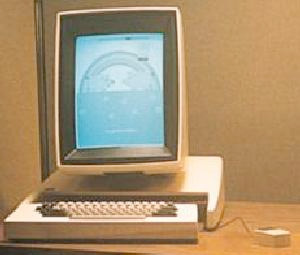
In workstations of the past, graphics and commands where split between three different screens, a vector device for line graphics, a text display for entering commands, and a video / raster graphics screen coupled with a frame buffer to display the final rendered result. Xerox PARC combined these separate technologies into one raster graphics screen along with an easier way of issuing commands: the pop up menus, icons, and desktop metaphor of the graphical user interface. While mainline computer engineers scoffed at the idea of one computer for each person, the Xerox team built the Alto personal computer. Traditional computer applications centered on number and data manipulation; the Xerox team focused on words, design and communications.

The researcher roster at PARC reads like a who’s who of the CGI world. As with many other areas of computer graphics, researchers from the University of Utah would play a key role in the development of the GUI and other products developed at PARC. The idea for GUI was actually first developed by Alan Kay from the University of Utah who went to work at PARC on the Alto project in 1970. Kay and Ed Cheadle built a computer called FLEX at the University of Utah between 1967 and 1969 that included the rudimentary elements of a GUI, including multiple tiled windows and square icons representing data and programs.
The first GUIs tried at Xerox PARC were very difficult to work with and depended too much on the processor to re-draw each bit when moving overlapping windows around. In 1974 a PARC researcher named Dan Ingalls , who was one of the principle architects of the Smalltalk object oriented language, invented a procedure for the movement of whole blocks of bits on the screen called “Bit Blit”, or BitBLT. This display algorithm allowed overlapping windows to be quickly shuffled around the screen without overtaxing the processor.
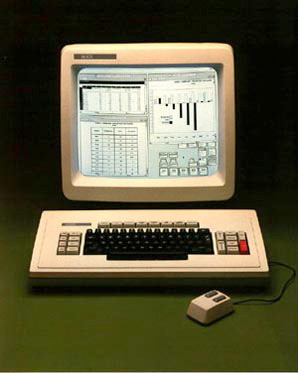
The Xerox Star was the first commercial personal computer to use the now common desktop metaphor. David Smith, developer of the Star interface, said in a 1982 article:
“Every user’s initial view of the Star is the Desktop, which resembles the top of an office desk, together with surrounding furniture and equipment. It represents a working environment, where projects and accessible resources reside. On the screen are displayed pictures of familiar office objects, such as documents, folders, file drawers, in-baskets, and out-baskets. These objects are displayed as small pictures, or icons.”
PARC was initially divided into three units: the Computer Science Lab (CSL), the Systems Science Lab (SSL), and the General Science Lab (GSL). The CSL, run by Bob Taylor, was most responsible for the development of the graphical user interface. Taylor had worked on the ARPAnet, (a distributed network of computers, the predecessor to the Internet) and brought the idea of networked computers to PARC.
By 1979 there were hundreds of Altos networked together with more traffic and ‘nodes’ than the entire ARPAnet. Xerox PARC even had the world’s first computer virus called a ‘tapeworm’ because it would eat it’s way through the Ethernet and consume all available resources. Like many of PARC’s innovations networking was ahead of it’s time, and would not be widely available in personal computers for another decade.
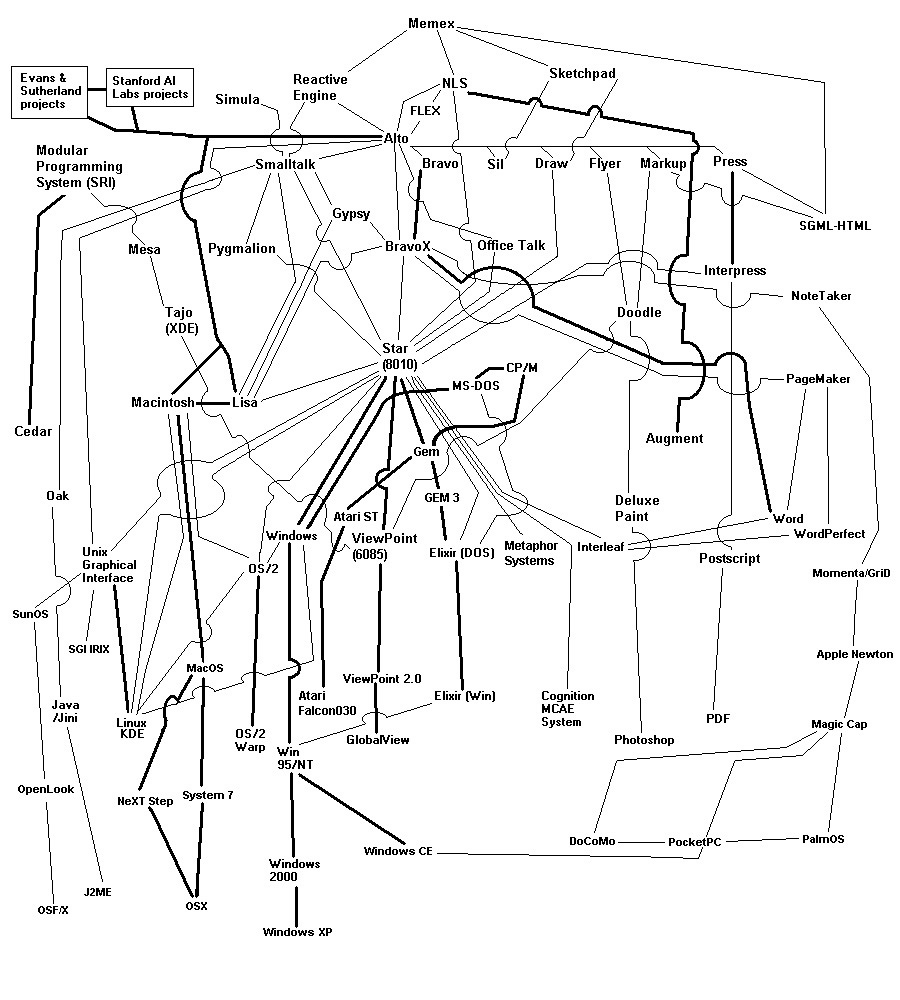
In 1979, Xerox decided against marketing the Alto system. By then the organization barely resembled the buoyant company that a decade earlier had challenged both IBM and the office of the future. External factors including fierce competition, government antagonism, and economic recession all marked Xerox’s slide from overconfidence to loss of confidence. Internal forces were even more combustible, as the company’s research, finance, and marketing groups each pursued a separate vision of the “right” Xerox future. In the end, the company that invented the first version of the personal computing future found itself struggling to recapture the advantages of its copier past.
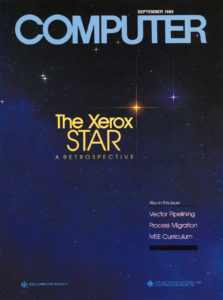
Alto had the ability to show other computers on the network as icons on it’s graphical desktop. Much later Macintosh acquired this ability. With the birth of the Internet and the World Wide Web, computers could network to others across the world, but this was done with a separate application that was at first nongraphical (telnet, text-based FTP software). Later applications for accessing the internet became more GUI-like but were not part of the operating system (TurboGopher, Fetch, Anarchie). With the introduction of the first graphical web browser, Mosaic, in 1993 accessing the internet began to look more like an environment one would see with a GUI.
With the release of Windows 95 and NT, Microsoft attempted to blur the distinction of the web browser application and operating system by bundling Windows 95 with Internet Explorer. The windows and interface of Windows 95 could be set so that browsing the local computer looked almost the same as browsing the Internet. Microsoft got into legal trouble because the bundling strategy was seen as an attempt to block competition from Netscape and other browsers. (See Landgrave article listed in bibliography box below)
John Warnock (University of Utah) helped develop Interpress and other printing and page description systems at PARC which allowed the Alto to become the first WYSIWYG computer when coupled with Xerox’s laser printer. Later Warnock founded Adobe Systems which along with Apple computer helped bring about the desktop publishing revolution of the late 1980s . The combination of the Macintosh, the LaserWriter, and Adobe’s page description software would forever change the world of publishing, typesetting, and graphic design.
Larry Tesler at PARC, who would later be part of the Apple LISA development team, began work on Gypsy, the world’s first user friendly word processing application using pop-up menus and icons in 1974. Gypsy was later to become the basis for Microsoft Word when it’s co-creator Tim Mott and others at PARC went to work at Microsoft. Gypsy was essentially the world’s first desktop publishing software with advanced features such as drawing and editing graphics within the same application as the word processor. These features began to emerge in software packages such as Adobe InDesign and QuarkXpress.
It is widely believed that the Xerox corporate management never realized what they had at PARC — it seems that they never shared the same vision as the researchers. The innovations developed there were never marketed successfully under the Xerox name. It took outside companies to market PARC innovations in GUI and WYSIWYG to make them the standards they are today.
“Office automation has emerged as a full-blown systems approach that will revolutionize how offices work.” (Business Week, June 1975)
“The basic purpose of Xerox Corporation is to find the best means to bring greater order and discipline to information. Thus, our fundamental thrust, our common denominator, has evolved towards establishing leadership in what we call ‘the architecture of information’. What we seek is to think of information itself as a natural and undeveloped environment which can be enclosed and made more habitable for the people who live and work within it. “ (C. Peter McCulough, CEO Xerox Corporation)
“None of the main body of the company was prepared to accept the answers. So there was a tremendous mismatch between the management and what the researchers were doing and these guys had never fantasized about what the future of the office was going to be. When it was presented to them they had no mechanisms for turning those ideas into real live products and that was really the frustrating part of it. You were talking to people who didn’t understand the vision and yet the vision was getting created everyday within the Palo Alto Research Centre and there was no one to receive that vision.” (John Wamock)
“People came there specifically to work on five year programs that were their dreams.” (Adele Goldberg, Former Xerox PARC Researcher )
“Everybody wanted to make a real difference, we really thought that we were changing the world and that at the end of this project or this set of projects personal computing would burst on the scene exactly the way we had envisioned it and take everybody by total surprise.” ( Larry Tesler)
Here is a sampling of PARC contributions. To view a timeline of GUI contributions, see Section 5 in this chapter.
- The Alto – The first personal computer, the Alto embodied such innovations as the world’s first WYSIWYG editor, commercial mouse, graphical user interface (GUI) and bit-mapped display.
- Client/Server Architecture – This approach was a paradigm shift that moved the computer industry away from the hierarchical world of centralized mainframes downloading to dumb terminals and toward more distributed access to information resources.
- Ethernet – Ethernet became the global standard for interconnecting computers on local area networks. The Ethernet standard spawned a series of increasingly sophisticated networking protocols that not only enabled distributed computing, but led to a re-architecting of the internal computer-to-computer communication within Xerox copiers and duplicators. The 10 Series copiers were the first to use numerous built-in microcomputers with a low-bandwidth Ethernet as the communications interface.
- Network Architecture – The development of Ethernet, Alto and research prototypes of networking protocols for distributed computing led to the development of XNS, Xerox’ robust, leading-edge networking protocol. This led to the Corporate Internet, an internal wide area enterprise network that was well ahead of its time in enabling employees to exchange formatted documents worldwide with speed and ease. In fact, with Xerox’ STAR system, 1981, users were able to access file servers and printers around the world through simple point-and-click actions, a functionality that has yet to be matched by today’s computing systems.
- Internet Standards – PARC scientists are playing a leading role in designing the protocols that will govern and define how the Internet will work in the future. The “M-Bone” multicast backbone, a collaboration between PARC and several universities from around the world, was first implemented at PARC and has been delivering realtime video over the Internet since 1992. Currently, a PARC research team has been chosen by the World Wide Web Consortium to lead the design for the next generation of HTTP.
- Glyphs – PARC is a world leader developing embedded data schemes that transform paper into a user interface. Glyphs are used in many applications, including data verification and finishing applications.
- Information Visualization – PARC’s unique approach to the visualization of information uses people’s perceptual and cognitive capacities to help them deal with large amounts of information. The approach was originally used in 3-D Rooms and was an integral technique used in the Xerox product Visual Recall. The hyperbolic browser, which could revolutionize the way people access information on the Internet, and other focus-plus-context visualization techniques are part of the foundation for Inxight, a Xerox New Enterprise Company.
- Collaborative Tools – Work on collaborative tools, beginning with Colab, resulted in the development of a product for document-based group collaboration called LiveBoard. This technology, which spawned a business unit called LiveWorks, enabled colleagues – both locally and in remote sites – to work together using real-time, multi-media documents. More recently, research on how a sense of place can create more meaningful interaction on the Internet has turned into a spin-out company called Placeware, in which Xerox holds a partial interest
- Flat Panel Display – Work in amorphous silicon led to the development of thin film transistors. Arrays of these devices now provide for a new generation of flat, print-quality displays. This technology, resulted in the formation of dpiX, a Xerox New Enterprise Company. The panels that are used to make electronic documents as easy to read as paper documents have also found application in document scanning and digital X-ray imaging.
- Laser Printing – Electronic printing provided a means of seamlessly transferring digital documents into the paper domain. The original idea of modulating a laser to create an electronic image on a copier’s drum migrated from Rochester to the newly-formed PARC where it became the basis for Xerox’ multi-billion dollar printing business. The early Raster Output Scanner optical designs for Xerox laser printers were also developed at PARC. This invention changed the entire notion of documents and document processing.
- Page Description Languages – Page Description Languages enable the construction of documents from higher-level sources. They are the intermediaries between tools for creating documents and devices for displaying them. Press, the first PDL, was developed by PARC scientists and greatly influenced the design of Interpress and PostScript.
- Device Independent Imaging – A software document architecture that enables device dependent aspects of imaging to be cleanly separated from generic imaging operations, Device Independent Imaging has been a research thrust at PARC for a number of years. This work is enabling Xerox printing products such as DocuPrint to drive different Xerox printers from a common software base.
- Laser Diodes – PARC’s laser research has made Xerox a world leader in semiconductor laser diodes, resulted in hundreds of patents and spawned Spectra Diode Laboratories. Laser diodes are used in all new Xerox printing products. Multi-beam Lasers – PARC was the first organization in the world to create a multi-beam laser diode and Xerox is, to date, the only printing company to have this capability. The dual-beam laser emits two beams rather than the a standard single beam, making it possible to print twice as fast. The dual-beam laser is in use in Xerox’ flagship product, the DocuTech 180, and is being incorporated in Xerox’ new DocuCenter color products.
- Blue Lasers – In October of 1997, Xerox PARC was the first printing company to create a blue laser. The reduced wavelength of a blue laser allowed much higher resolution printing than was possible with standard red and infrared lasers.
- DocuPrint – The system that drives Xerox high-end, network based printers brought together two decades of knowledge and a number of technologies including higher level languages, integrated software for page description and device independent imaging.
- Integrated AI Environments – Interlisp is an ACM award-winning integrated environment that supports artificial intelligence applications. It combines ideas for rapid prototyping with explicit knowledge representation. With the Loops object-oriented extensions, it was used to develop a number of valuable knowledge-based systems for Xerox.
- BITbIt – This small but important invention enables programmers, without special hardware, to manipulate images very rapidly. The “bit blasting” computer command enables the quick manipulation of the pixels of an image and was built into the instruction code of the Alto.
- Mesa/Cedar – Mesa is a system programming language developed at PARC that incorporated mechanisms for making software more reliable, while supporting rapid development. Many of the ideas from this language were used in the development of ADA, the standard DOD language. Mesa was used to implement much of DocuTech software. Cedar, a successor to Mesa also developed at PARC, enabled the rapid development of the DocuPrint system.
- Object-Oriented Programming – The notion of objects that are described and addressed individually and that can be linked together with other objects without having to rewrite a entire program has revolutionized the software industry. PARC’s early and continuing work in this area makes it a world leader. SmallTalk, developed at PARC, was one of the first successful object-oriented languages and led to the spinoff of PARCPIace Systems. All current software development at Xerox uses an object-oriented methodology.
- Expert Systems – PARC researchers developed the Interlisp-D environment for Al programming as well as a variety of applications utilized within Xerox. For example, Trillium enables the quick simulation of new user interface designs and Pride captures engineers’ experience and rules of thumb for designing paper paths using pinch rollers.
- VLSI Design Methodology – A new representation of VLSI (very large scale integration) integrated circuit designs led to a new generation of computer-aided design (CAD) tools, reduced design time and spawned the silicon foundry industry. Linguistic Compression Technology – Based on an understanding of the deep structure and mathematical properties of language, this technology is used for visual recall, intelligent retrieval and linguistic compression. This work has had a major impact on the automatic processing of language structures and is one of the key research areas underpinning Xerox’ Multilingual Suite of products.
- Constraint-Based Scheduling – This technology uses intelligent modeling to create real time machine control, providing the planning software that enables the DocuCenter “plug and play” family of copiers. It gives Xerox a competitive hardware advantage by enabling very effective and efficient machine control at the customer site. Reusable models also improve time to market and performance quality.
- Smart Service – Smart Service provides workers with the tools for generating information systems that enable productivity and learning through lateral communication. One implementation is the Eureka knowledge-sharing system which has helped field service technicians in France, Canada and the U.S. dramatically improve their productivity and the quality of service delivered to Xerox customers.
- Work Practice Studies – Ethnographic studies conducted by PARC social scientists have revealed how people really work and what they need from technology. By observing the practices of customers using copiers, field service technicians doing repairs and people doing office work, PARC researchers have evolved a community based approach to the design and use of technology.
Movie 16.1 XEROX STAR demo (1982)
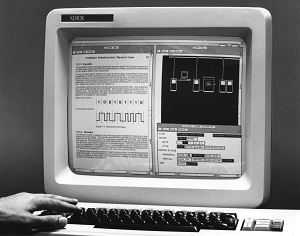
http://www.youtube.com/watch?v=Cn4vC80Pv6Q
Marcin Wichary’s excellent collection of GUI material – GUIdebook: Graphical User Interface Gallery
http://www.guidebookgallery.org/
The Graphical User Interface
http://www.sitepoint.com/article/real-history-gui
Xerox PARC history
https://www.parc.com/about-parc/parc-history/
1972: Xerox PARC and the Alto
http://www.cnn.com/TECH/computing/9907/08/1972.idg/
Microsoft’s Settlement: the End of an Era, Tim Landgrave
http://www.techrepublic.com/article/microsofts-settlement-the-end-of-an-era/
- Thanks to graduate students John Buck and Jon Gladden for their contributions to this chapter. ↵
